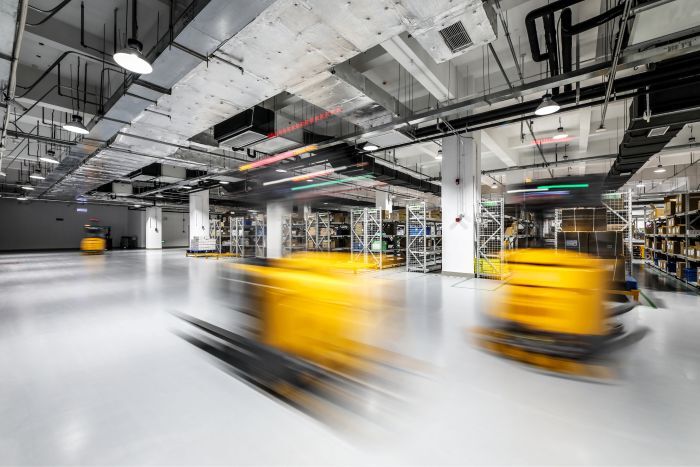Best Warehouse Automation Tools for Load Planning

Warehouse teams have a lot on their plates. One of the biggest tasks is moving inventory. With the e-commerce boom and the push for faster, more reliable deliveries, businesses can't afford to waste time or space. That's where automated load planning steps in—it streamlines the process, making everything more efficient.
The result? Big savings, fewer mistakes, and better use of warehouse space.
Load planning is all about making the most out of your space. It helps you pack items neatly into warehouses, containers, or delivery vehicles, fully utilizing a vehicle's loading capacity and saving costs.
In this article, we'll walk you through the key principles and benefits of load planning so you can see why it matters. Let's dive in!
What is Load Planning in Warehouse Automation?
Load planning is about figuring out the optimal way to organize and pack items onto delivery vehicles and warehouses. It considers weight, size, destination, and how they must be handled. The goal is to ensure everything is packed in the safest, most efficient, and cost-effective way.
In warehouse automation, load planning goes beyond just arranging items. It's about using technology and data to get the job done right.
Automated systems—like robots, machine learning algorithms, and advanced software—handle the heavy lifting. They make the loading process faster and more accurate, reducing time and mistakes.
5 Benefits of Load Planning in Warehouse Automation
How does efficient load planning impact your overall supply chain performance?
Well, it speeds up loading, makes it more reliable, and relies on data, saving you loads of money.
Here's a closer look at the benefits:
Better Space Utilization: Optimized load planning means you can fit more inventory in the same area without expanding your warehouse. It's a huge plus, especially when dealing with limited or expensive warehouse space.
Lower Labor Costs: Automating load planning reduces manual labor and human errors. With repetitive tasks handled automatically, you can shift employees to roles that add more value while saving on labor costs.
Improved Safety: Accidents are common with poorly planned loads, especially involving heavy or hazardous items. Automatic load planning tools reduce the risk of workplace injuries.
Improved Delivery Efficiency: Unloading is a breeze when items are loaded systematically onto delivery trucks. This speeds up delivery times and leads to better customer service.
Environmental Impact: Load planning lowers fuel consumption and emissions by reducing the number of trips needed, significantly reducing your carbon footprint.
Now that we know the benefits load planning provides in warehouse automation let's understand the tools that make it possible.
Best Tools for Load Planning in Warehouse Automation
Depending on your industry and the type of products, you can choose the best software to fit your load planning needs. Here are some of the most popular options:
1. Warehouse Management Systems (WMS)
A Warehouse Management System (WMS) gives you control over your day-to-day operations with valuable insights through detailed reports. Modern WMS platforms often include features that are specifically designed to make load planning easier, like:
-
Inventory Tracking: Provides real-time information about your inventory’s location and status, so you can place items optimally within the warehouse.
-
Order Prioritization: Identifies high-priority orders, ensuring they are loaded efficiently for easy access.
-
Space Utilization Reports: Analyzes your available space and suggests ways to organize products to maximize your storage capacity.
2. Load Optimization Software
Load optimization software is a specialized tool that makes handling complex load planning easy—no more updating Excel sheets. This software considers load type, vehicle size, and dimensions, and uses smart algorithms to determine the best packing arrangement in a truck or container.
Here are some standout features you might find useful:
-
Dynamic Load Building: Automatically tweaks load configurations based on item specifications and delivery needs.
-
3D Visualization: Allows you to visualize load plans in 3D, ensuring items are packed safely and efficiently.
- Real-time Adjustment: Gives you the flexibility to make changes on the go, helping you quickly adapt to any last-minute surprises.
3. Load Planning Data Analytics
Data analytics algorithms use past data to find patterns and predict future demand. Load planning data analytics boosts decision-making, accuracy, and efficiency and helps create what-if scenarios.
-
Demand Forecasting: Predicts high-demand items or priority orders so you can prioritize load planning for these items.
-
Load Pattern Recognition: Identifies the best load configurations using product and vehicle details and successful past load plans.
-
Real-Time Decision-Making: AI adjusts load plans on the spot, optimizing layouts as conditions change.
Now that you know the tools, let's explore the best techniques for effective load planning!
Techniques for Effective Load Planning in Warehouse Automation
Curious about how to make load planning more efficient?
Many techniques can help—some are built into the tools, while others are practical strategies your team can use. Let’s break them down:
A- Pre-Plan Loading Sequences
Pre-planning loading sequences based on delivery routes and priority items is key to smooth operations. Arrange items in reverse order of unloading, so drivers can grab each item in the right sequence without reshuffling at every stop.
-
Route-Based Loading: Use WMS and GPS data to match loading sequences with delivery routes.
-
Prioritize High-Demand Items: Keep high-demand or time-sensitive items near the loading area for quick access.
B- Use Slotting Optimization
Slotting means grouping products in the warehouse by demand, size, and handling needs. A good slotting strategy speeds up loading and unloading and reduces travel and pick time.
-
Slotting A-B-C: Sorts items into A (high demand), B (moderate demand), and C (low demand) categories and places them based on access frequency.
-
Dynamic Slotting: Adjusts item locations for seasonal demand or special promotional offers.
C- Integrate Real-Time Tracking and Monitoring
Real-time tracking with IoT sensors and GPS lets you monitor loading progress and spot issues instantly. This prevents delays and keeps everything on track as per the load plan.
-
Real-Time Load Verification: Use RFID tags or barcodes to check each item as it's loaded, ensuring zero misses.
-
Proactive Issue Resolution: Get alerts for any discrepancies, like missing items or incorrect loading, and can fix them right away.
D- Prioritize Safety & Stability
How can you make load planning safer? It's essential if you handle heavy or hazardous materials. Balanced and secure loads lower the risk of accidents during transport. Here’s how you can prioritize safety:
-
Distribution of Weights: Spread heavy items evenly to keep the vehicle stable.
-
Safety Focus: Use straps, pallets, or braces to secure items and prevent shifting during transit.
E- Regularly Review and Adjust Load Plans
Keep your load plans effective by staying flexible and making regular adjustments. Warehouse conditions change often, review your load planning strategies and make adjustments. Here’s what to do:
-
Performance Analysis: Use data to track KPIs like load time and vehicle utilization rate to find areas to improve.
-
Continuous Improvement: Update load plans based on feedback from drivers and warehouse staff for smoother operations.
Optimize Load Planning with C3 Solutions
Ready to make your load planning easier and more efficient?
Smart load planning is the backbone of successful warehouse operations. Automating the process can cut labor costs, boost safety, and improve delivery performance. Using tools like WMS, data analytics, and the load planning techniques we’ve covered, you’ll have a solid strategy in place.
At C3 Solutions, we understand the challenges of modern load planning and have developed tools to simplify and automate the process for you. Our solutions give you complete visibility, helping you optimize load preparation and streamline your workflow.
Curious to see how we add value to your warehouse processes?
Contact C3 Solutions today to discover how we can make your warehouse more efficient, manage peak loads smoothly, and take your load planning to the next level with automation!



